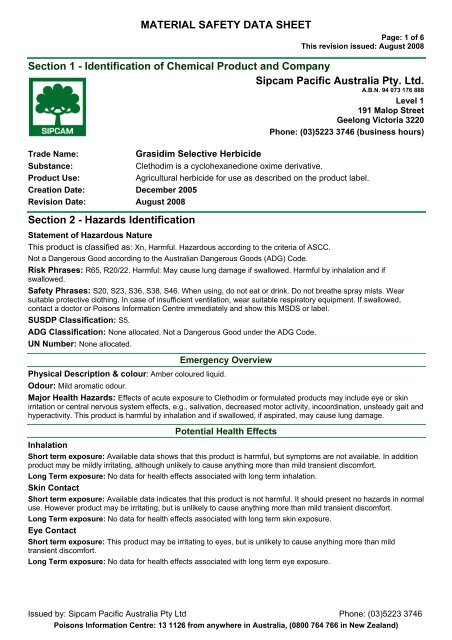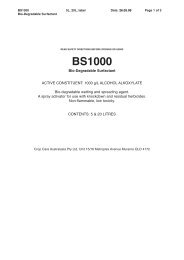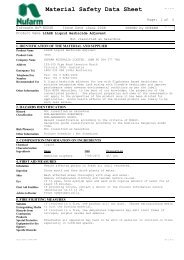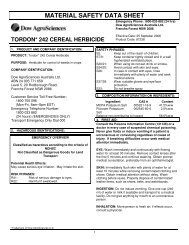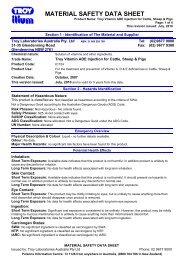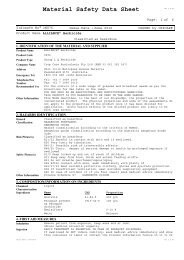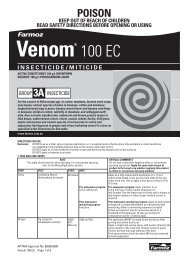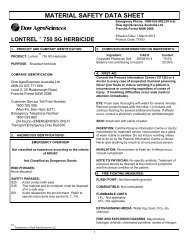Grasidim Selective Herbicide - Agsure
Grasidim Selective Herbicide - Agsure
Grasidim Selective Herbicide - Agsure
- No tags were found...
You also want an ePaper? Increase the reach of your titles
YUMPU automatically turns print PDFs into web optimized ePapers that Google loves.
MATERIAL SAFETY DATA SHEETPage: 1 of 6This revision issued: August 2008Section 1 - Identification of Chemical Product and CompanySipcam Pacific Australia Pty. Ltd.A.B.N. 94 073 176 888Level 1191 Malop StreetGeelong Victoria 3220Phone: (03)5223 3746 (business hours)Trade Name:<strong>Grasidim</strong> <strong>Selective</strong> <strong>Herbicide</strong>Substance:Clethodim is a cyclohexanedione oxime derivative.Product Use:Agricultural herbicide for use as described on the product label.Creation Date: December 2005Revision Date: August 2008Section 2 - Hazards IdentificationStatement of Hazardous NatureThis product is classified as: Xn, Harmful. Hazardous according to the criteria of ASCC.Not a Dangerous Good according to the Australian Dangerous Goods (ADG) Code.Risk Phrases: R65, R20/22. Harmful: May cause lung damage if swallowed. Harmful by inhalation and ifswallowed.Safety Phrases: S20, S23, S36, S38, S46. When using, do not eat or drink. Do not breathe spray mists. Wearsuitable protective clothing. In case of insufficient ventilation, wear suitable respiratory equipment. If swallowed,contact a doctor or Poisons Information Centre immediately and show this MSDS or label.SUSDP Classification: S5.ADG Classification: None allocated. Not a Dangerous Good under the ADG Code.UN Number: None allocated.Emergency OverviewPhysical Description & colour: Amber coloured liquid.Odour: Mild aromatic odour.Major Health Hazards: Effects of acute exposure to Clethodim or formulated products may include eye or skinirritation or central nervous system effects, e.g., salivation, decreased motor activity, incoordination, unsteady gait andhyperactivity. This product is harmful by inhalation and if swallowed, if aspirated, may cause lung damage.Potential Health EffectsInhalationShort term exposure: Available data shows that this product is harmful, but symptoms are not available. In additionproduct may be mildly irritating, although unlikely to cause anything more than mild transient discomfort.Long Term exposure: No data for health effects associated with long term inhalation.Skin ContactShort term exposure: Available data indicates that this product is not harmful. It should present no hazards in normaluse. However product may be irritating, but is unlikely to cause anything more than mild transient discomfort.Long Term exposure: No data for health effects associated with long term skin exposure.Eye ContactShort term exposure: This product may be irritating to eyes, but is unlikely to cause anything more than mildtransient discomfort.Long Term exposure: No data for health effects associated with long term eye exposure.Issued by: Sipcam Pacific Australia Pty Ltd Phone: (03)5223 3746Poisons Information Centre: 13 1126 from anywhere in Australia, (0800 764 766 in New Zealand)
MATERIAL SAFETY DATA SHEETPage: 2 of 6This revision issued: August 2008IngestionShort term exposure: Significant oral exposure is considered to be unlikely. Because of the low viscosity of thisproduct, it may directly enter the lungs if swallowed, or if subsequently vomited. Once in the lungs, it is very difficult toremove and can cause severe injury or death. However, this product may be irritating to mucous membranes but isunlikely to cause anything more than transient discomfort.Long Term exposure: No data for health effects associated with long term ingestion.Carcinogen StatusASCC: No significant ingredient is classified as carcinogenic by ASCC.NTP: No significant ingredient is classified as carcinogenic by NTP.IARC: No significant ingredient is classified as carcinogenic by IARC.Section 3 - Composition/Information On IngredientsIngredients CAS No Conc,% TWA (mg/m 3 ) STEL (mg/m 3 )Clethodim 99129-21-2 240g/L not set not setLiquid hydrocarbon 64742-94-5 657g/L not set not setOther non hazardous ingredients secret to 100 not set not setThis is a commercial product whose exact ratio of components may vary slightly. Minor quantities of other nonhazardous ingredients are also possible.The ASCC TWA exposure value is the average airborne concentration of a particular substance when calculated over a normal 8 hour working dayfor a 5 day working week. The STEL (Short Term Exposure Limit) is an exposure value that may be equalled (but should not be exceeded) for nolonger than 15 minutes and should not be repeated more than 4 times per day. There should be at least 60 minutes between successive exposuresat the STEL. The term "peak "is used when the TWA limit, because of the rapid action of the substance, should never be exceeded, even briefly.Section 4 - First Aid MeasuresGeneral Information:You should call The Poisons Information Centre if you feel that you may have been poisoned, burned or irritated bythis product. The number is 13 1126 from anywhere in Australia (0800 764 766 in New Zealand) and is available at alltimes. Have this MSDS with you when you call.Inhalation: If symptoms of poisoning become evident, contact a Poisons Information Centre, or call a doctor atonce. Remove source of contamination or move victim to fresh air. If breathing is difficult, oxygen may be beneficial ifadministered by trained personnel, preferably on a doctor's advice. DO NOT allow victim to move aboutunnecessarily. Symptoms of pulmonary oedema can be delayed up to 48 hours after exposure.Skin Contact: Gently blot away excess liquid. Wash gently and thoroughly with water (use non-abrasive soap ifnecessary) for 5 minutes or until chemical is removed.Eye Contact: No effects expected. If irritation does occur, flush contaminated eye(s) with lukewarm, gently flowingwater for 5 minutes or until the product is removed. Obtain medical advice if irritation becomes painful or lasts morethan a few minutes. Take special care if exposed person is wearing contact lenses.Ingestion: If swallowed, do NOT induce vomiting. Wash mouth with water and contact a Poisons InformationCentre, or call a doctor.Section 5 - Fire Fighting MeasuresFire and Explosion Hazards: This product is classified as flammable. There is no risk of an explosion from thisproduct under normal circumstances if it is involved in a fire. Violent steam generation or eruption may occur uponapplication of direct water stream on hot liquids. Vapours from this product are heavier than air and may accumulatein sumps, pits and other low-lying spaces, forming potentially explosive mixtures. They may also flash backconsiderable distances.Fire decomposition products from this product may be toxic if inhaled. Take appropriate protective measures.Extinguishing Media: Suitable extinguishing media are carbon dioxide, dry chemical, foam, water fog.Fire Fighting: If a significant quantity of this product is involved in a fire, call the fire brigade.Flash point:Upper Flammability Limit:Lower Flammability Limit:Autoignition temperature:Flammability Class:>62°C, Closed cupNo data.No data.No data.FlammableIssued by: Sipcam Pacific Australia Pty Ltd Phone: (03)5223 3746Poisons Information Centre: 13 1126 from anywhere in Australia, (0800 764 766 in New Zealand)
MATERIAL SAFETY DATA SHEETPage: 3 of 6This revision issued: August 2008Section 6 - Accidental Release MeasuresAccidental release: In the event of a major spill, prevent spillage from entering drains or water courses. Wear fullprotective clothing including eye/face protection. All skin areas should be covered. See below under PersonalProtection regarding Australian Standards relating to personal protective equipment. Suitable materials for protectiveclothing include rubber, PVC. Eye/face protective equipment should comprise as a minimum, protective goggles. Ifthere is a significant chance that vapours or mists are likely to build up in the cleanup area, we recommend that youuse a respirator. It should be fitted with a type G cartridge, suitable for agricultural chemicals. Otherwise, not normallynecessary.Stop leak if safe to do so, and contain spill. Absorb onto sand, vermiculite or other suitable absorbent material. If spillis too large or if absorbent material is not available, try to create a dike to stop material spreading or going into drainsor waterways. Sweep up and shovel or collect recoverable product into labelled containers for recycling or salvage,and dispose of promptly. Recycle containers wherever possible after careful cleaning. Refer to product label forspecific instructions. After spills, wash area preventing runoff from entering drains. If a significant quantity of materialenters drains, advise emergency services. Full details regarding disposal of used containers, spillage and unusedmaterial may be found on the label. If there is any conflict between this MSDS and the label, instructions on the labelprevail. Ensure legality of disposal by consulting regulations prior to disposal. Thoroughly launder protective clothingbefore storage or re-use. Advise laundry of nature of contamination when sending contaminated clothing to laundry.Section 7 - Handling And StorageHandling: Keep exposure to this product to a minimum, and minimise the quantities kept in work areas. CheckSection 8 of this MSDS for details of personal protective measures, and make sure that those measures are followed.The measures detailed below under "Storage" should be followed during handling in order to minimise risks topersons using the product in the workplace. Also, avoid contact or contamination of product with incompatiblematerials listed in Section 10.Storage: This product is a Scheduled Poison. Observe all relevant regulations regarding sale, transport and storageof this schedule of poison. Store in the closed original container in a dry, cool, well-ventilated area out of directsunlight. Make sure that the product does not come into contact with substances listed under "Incompatibilities" inSection 10. Some liquid preparations settle or separate on standing and may require stirring before use. Checkpackaging - there may be further storage instructions on the label.Section 8 - Exposure Controls And Personal ProtectionThe following Australian Standards will provide general advice regarding safety clothing and equipment:Respiratory equipment: AS/NZS 1715, Protective Gloves: AS 2161, Industrial Clothing: AS2919, Industrial EyeProtection: AS1336 and AS/NZS 1337, Occupational Protective Footwear: AS/NZS2210.ASCC Exposure limits TWA (mg/m 3 ) STEL (mg/m 3 )Exposure limits have not been established by ASCC for any of the significant ingredients in this product.The ADI for Clethodim is set at 0.01mg/kg/day. The corresponding NOEL is set at 1mg/kg/day. ADI meansAcceptable Daily Intake and NOEL means No-observable-effect-level. Values taken from Australian ADI List, April2008.No special equipment is usually needed when occasionally handling small quantities. The following instructions arefor bulk handling or where regular exposure in an occupational setting occurs without proper containment systems.Ventilation: This product should only be used in a well ventilated area. If natural ventilation is inadequate, use of afan is suggested.Eye Protection: Eye protection such as protective glasses or goggles is recommended when product is being used.Skin Protection: You should avoid contact even with mild skin irritants. Therefore you should wear suitableimpervious elbow-length gloves and facial protection when handling this product. See below for suitable types.Protective Material Types: We suggest that protective clothing be made from the following: rubber, PVC.Respirator: Usually, no respirator is necessary when using this product. However, if you have any doubts consultthe Australian Standard mentioned above. Otherwise, not normally necessary.Safety deluge showers should, if practical, be provided near to where this product is being used.Section 9 - Physical And Chemical Properties:Physical Description & colour: Amber coloured liquid.Odour:Mild aromatic odour.Boiling Point:Not available.Issued by: Sipcam Pacific Australia Pty Ltd Phone: (03)5223 3746Poisons Information Centre: 13 1126 from anywhere in Australia, (0800 764 766 in New Zealand)
MATERIAL SAFETY DATA SHEETFreezing/Melting Point: No specific data. Liquid at normal temperatures.Volatiles:No specific data. Expected to be low at 100°C.Vapour Pressure:Negligible at normal ambient temperatures.Vapour Density:No data.Specific Gravity: Approx 0.95 at 20°CWater Solubility:Emulsifiable.pH:3.6 (5% in water)Volatility:Negligible at normal ambient temperatures.Odour Threshold:No data.Evaporation Rate:No data.Coeff Oil/water distribution: No dataAutoignition temp:No data.Page: 4 of 6This revision issued: August 2008Section 10 - Stability And ReactivityReactivity: This product is unlikely to react or decompose under normal storage conditions. However, if you haveany doubts, contact the supplier for advice on shelf life properties.Conditions to Avoid: Store in the closed original container in a dry, cool, well-ventilated area out of direct sunlight.Incompatibilities: strong acids, strong bases, strong oxidising agents.Fire Decomposition: Carbon dioxide, and if combustion is incomplete, carbon monoxide and smoke. Nitrogen andits compounds, and under some circumstances, oxides of nitrogen. Occasionally hydrogen cyanide gas in reducingatmospheres. Oxides of sulfur (sulfur dioxide is a respiratory hazard) and other sulfur compounds. Most will have afoul odour. Hydrogen chloride gas, other compounds of chlorine. Water. Carbon monoxide poisoning producesheadache, weakness, nausea, dizziness, confusion, dimness of vision, disturbance of judgment, andunconsciousness followed by coma and death.Polymerisation: This product will not undergo polymerisation reactions.Section 11 - Toxicological InformationThere is no data to hand indicating any particular target organs.Toxicity: An information profile for Clethodim is available at http://extoxnet.orst.edu/pips/ghindex.htmlAcute Toxicity: Clethodim is harmful by ingestion. The reported oral LD50 is 1,630 mg/kg and 1,360 mg/kg in maleand female rats, respectively. Clethodim is practically non-toxic by dermal absorption. The reported dermal LD50 isgreater than 5,000 mg/kg. The technical product did not cause skin irritation in the rabbit, but formulation causedmoderate skin as well as eye irritation in the rabbit. Eye irritation was reversible within 8-21 days. No data regardingskin sensitization or eye irritation were available for the technical product. Clethodim is practically non-toxic by theinhalation route. The reported rodent 4-hour inhalation LC50 for Clethodim technical is greater than 3.9 mg/L. Effectsof acute exposure to Clethodim or formulated products may include eye or skin irritation or central nervous systemeffects, e.g., salivation, decreased motor activity, incoordination, unsteady gait and hyperactivity. These latter effectsmay be in large measure due to the aromatic constituents of the formulation, as these effects commonly occur uponexposure to such compounds.Chronic Toxicity: In a one-year feeding study of dogs, doses of 75 mg/kg/day resulted in increased relative andabsolute liver weights, with anaemia-like alterations in blood chemistry such as reduced haemoglobin, erythrocyte andhaematocrit counts. In a two-year chronic study of rats, no compound-related effects on the structure and function ofthe liver were observed, and no changes in liver weights were observed at the highest dose tested, approximately 100mg/kg/day. Reduced body weight gain was observed in another study on rats at 350 mg/kg/day, but not at 100mg/kg/day, over an unspecified period.Reproductive Effects: No effects on fertility, length of gestation or growth and development of offspring wereobserved at doses up to and including the highest dose tested, 263 mg/kg/day.Teratogenic Effects: Data suggests that while there have been documented teratological effects in animal studies,such effects are unlikely in humans under normal conditions of exposure.Mutagenic Effects: The available data for mutagenicity and genotoxicity yield no evidence for mutagenic orgenotoxic activity.Carcinogenic Effects: No carcinogenic effects were observed in mice administered Clethodim at doses of 24mg/kg/day over an 18 month period. Based on the available data, it appears that Clethodim is not carcinogenic.Issued by: Sipcam Pacific Australia Pty Ltd Phone: (03)5223 3746Poisons Information Centre: 13 1126 from anywhere in Australia, (0800 764 766 in New Zealand)
MATERIAL SAFETY DATA SHEETPage: 5 of 6This revision issued: August 2008Organ Toxicity: The liver was the primary organ affected in chronic animal studies. Although potential effectsassociated with acute exposure are reported to include central nervous system effects, no available chronic datapointed to such effects.Fate in Humans & Animals: Clethodim is readily absorbed in the gastrointestinal tract, with approximately 90%absorption of oral doses. It is rapidly metabolized and eliminated (primarily sulfoxide metabolites, ca 63%) with lessthan 1% recoverable unchanged.Classification of Hazardous IngredientsIngredientLiquid HydrocarbonRisk PhrasesConc>=10%: Xn; R65Section 12 - Ecological InformationEffects on Birds: Clethodim is practically non-toxic to birds. Under likely conditions of use, it is unlikely to pose ahazard to avian species.Effects on Aquatic Organisms: Clethodim is slightly toxic to fish and aquatic invertebrate species. No effects wereseen at concentrations of 5.5 mg/L in Daphnia. No significant bioaccumulation has been observed in fish. Under likelyconditions of use, it is unlikely to pose a hazard to aquatic species.Effects on Other Animals (Nontarget species): Clethodim is practically non-toxic to honeybees with reported LD50s ofgreater than 100 μg/bee for both the technical product and formulated product. EPA has stated that "available wildlifedata indicate that the proposed uses on cotton and soybeans will result in minimal hazard to nontarget andendangered beneficial insect, avian and freshwater fish and mammalian species". Clethodim is selectively toxic toplants, affecting only grass species.ENVIRONMENTAL FATEBreakdown of Chemical in Soil and Groundwater: Clethodim is of low persistence in most soils with a reported half-lifeof approximately 3 days. Breakdown is mainly by aerobic processes, although photolysis may make somecontribution.Breakdown of Chemical in Surface Water: Clethodim may be highly persistent in the aquatic environment. Reportedhalf-lives for Clethodim in the aquatic environment are 128 days in the aqueous phase and 214 days in the sediment.The reported hydrolysis half-life at pH 7-9 is approximately 300 days.Breakdown of Chemical in Vegetation: Clethodim is rapidly degraded on the leaf surfaces by an acid-catalysedreaction and photolysis. Remaining Clethodim will rapidly penetrate the cuticle and enter the plant.Section 13 - Disposal ConsiderationsDisposal: Special help is available for the disposal of Agricultural Chemicals. The product label will give generaladvice regarding disposal of small quantities, and how to cleanse containers. However, for help with the collection ofunwanted rural chemicals, contact ChemClear 1800 008 182 http://www.chemclear.com.au/ and for help with thedisposal of empty drums, contact DrumMuster http://www.drummuster.com.au/ where you will find contact details foryour area.Section 14 - Transport InformationADG Code: This product is not classified as a Dangerous Good. No special transport conditions are necessaryunless required by other regulations.Section 15 - Regulatory InformationAICS: All of the significant ingredients in this formulation are compliant with NICNAS regulations.The following ingredients: Clethodim, Liquid hydrocarbon, are mentioned in the SUSDP.Section 16 - Other InformationThis MSDS contains only safety-related information. For other data see product literature.Acronyms:ADG CodeAustralian Code for the Transport of Dangerous Goods by Road and Rail, 7th EditionAICSAustralian Inventory of Chemical SubstancesASCCOffice of the Australian Safety and Compensation CouncilCAS numberChemical Abstracts Service Registry NumberIssued by: Sipcam Pacific Australia Pty Ltd Phone: (03)5223 3746Poisons Information Centre: 13 1126 from anywhere in Australia, (0800 764 766 in New Zealand)
MATERIAL SAFETY DATA SHEETPage: 6 of 6This revision issued: August 2008Hazchem NumberIARCNOSNTPR-PhraseSUSDPUN NumberCONTACT POINTSEmergency action code of numbers and letters that provide information to emergencyservices especially firefightersInternational Agency for Research on CancerNot otherwise specifiedNational Toxicology Program (USA)Risk PhraseStandard for the Uniform Scheduling of Drugs & PoisonsUnited Nations NumberAUSTRALIAPolice and Fire Brigade: Dial 000If ineffective: Dial 1100 (Exchange)For emergency response: Dial 1800 033 111National Poisons Information Centre:Dial 13 1126 (from anywhere in Australia)Please read all labels carefully before using product.The Material Safety Data Sheet (MSDS) augments the label and should not be used in place of regulatory approvedproduct labels which are attached to or accompanying the product container. This MSDS provides important health,safety and environmental information for personnel that are manufacturing, distributing, transporting and storing theproduct, including emergency responders and other product handlers. The label provides information specifically forproduct users.This MSDS is prepared in accord with the ASCC document “National Code of Practice for the Preparationof Material Safety Data Sheets” 2nd Edition [NOHSC:2011(2003)]Copyright © Kilford & Kilford Pty Ltd, March, 2011.http://www.kilford.com.au/ Phone (02)9251 4532Issued by: Sipcam Pacific Australia Pty Ltd Phone: (03)5223 3746Poisons Information Centre: 13 1126 from anywhere in Australia, (0800 764 766 in New Zealand)


